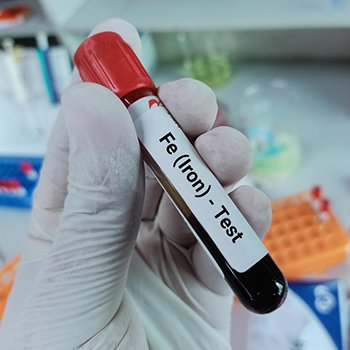- Home
-
Test Categories
- Diabetes
- Urinary
- Thyroid
- RTPCR
- Genetic
- Cancer
- Haematology
- Biochemistry
- Serology & Immunology
- Clinical Pathology
- Cytology
- Microbiology
- Endocrinology
- Histopathology
- MOLECULAR DIAGNOSTICS
- Pregnancy(Biochemistry)
- Liver
- Prostate
- Fertility
- Gastro
- Autoimmune Disorders
- Heart
- Kidney
- Vitamins
- Tuberculosis (TB)
- Anemia
- Fever
- Allergy
- Blood Tests Rare
- Profiles
- Packages
- About Us
- Why Choose Us
- Upload Prescription
- Corporate Wellness
- Contact Us

-
Overview
The Iron (Fe) Serum Test measures the amount of iron in the blood. Iron is a vital mineral necessary for producing hemoglobin, a protein in red blood cells that carries oxygen throughout the body. This test helps evaluate iron status and diagnose conditions such as iron deficiency anemia, iron overload disorders (like hemochromatosis), and other conditions affecting iron metabolism. The test is often ordered along with other tests like Total Iron Binding Capacity (TIBC), Transferrin, and Ferritin to get a complete picture of iron status.
Fasting Requirements:
- Fasting: Fasting for 8-12 hours is usually recommended before the test. The test is ideally done in the morning when serum iron levels are highest.
Sample Collection Process by Speediagno Phlebotomist or Technician
Speediagno follows a precise and professional protocol to ensure accurate blood sample collection for iron serum testing.
Preparation for Sample Collection:
- Identify the Patient: Confirm the patient’s identity using at least two identifiers (e.g., name and date of birth).
- Consent and Explanation: Explain the procedure to the patient, including the steps of blood collection.
Blood Sample Collection:
- Venipuncture Process:
- Position the Patient: The patient should be seated comfortably with the arm extended on a flat surface.
- Prepare the Site: Clean the venipuncture site (usually the inside of the elbow) with an antiseptic wipe to prevent infection.
- Blood Draw: A tourniquet is applied above the site to make the veins more visible. A sterile needle is inserted into the vein, and blood is drawn into a tube designed for serum iron testing (typically a red-top or gold-top tube without anticoagulant).
- Post-Collection Care: After drawing blood, the needle is removed, and pressure is applied with gauze to stop bleeding. A bandage is placed on the site.
- Venipuncture Process:
Safety and Hygiene Protocols:
- Proper Disposal: Dispose of used needles, gloves, and other materials in designated biohazard containers to ensure safety.
- Hand Hygiene: The phlebotomist should wash hands thoroughly after handling the sample.
Transport and Handling:
- Labeling: The tube is labeled with the patient’s information, including the date and time of collection.
- Transport to Lab: The sample should be transported promptly to the laboratory, following proper procedures to avoid hemolysis or other alterations that could affect test results.
All test groups and subgroup
-
IRON (Fe)
